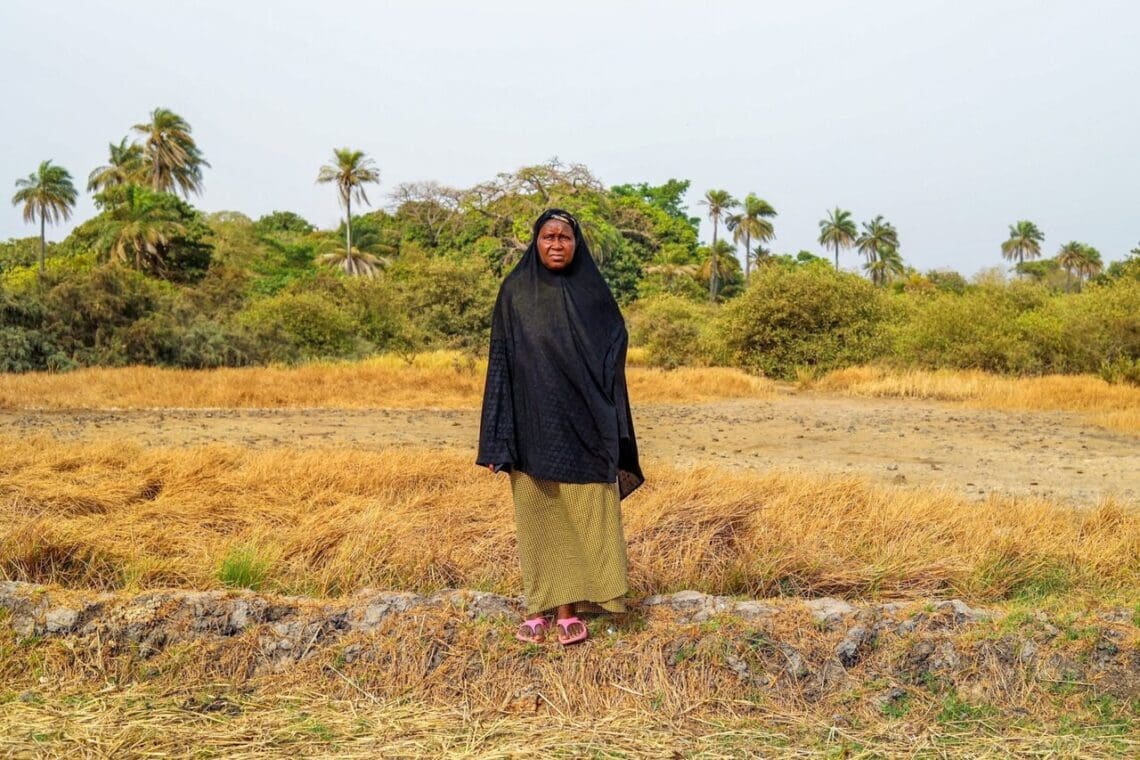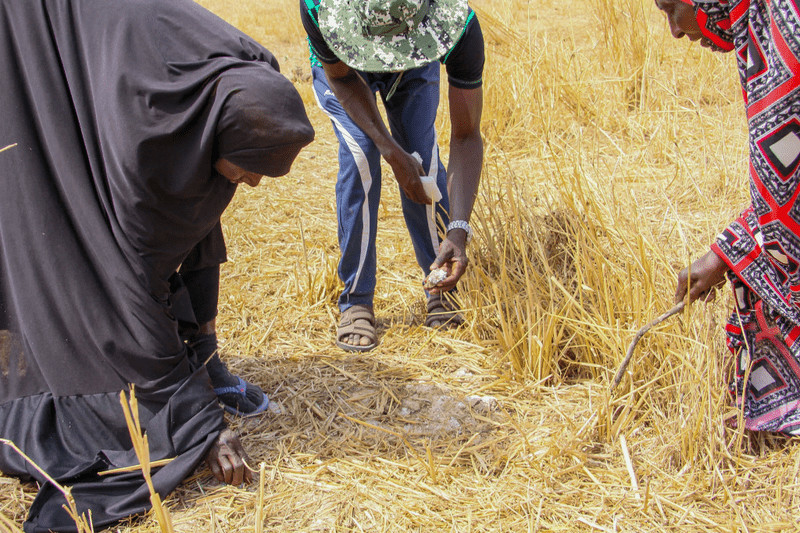
In The Gambia’s north-western Lower Niumi district, rice farmer Aja Fatou Sanneh looks out over land that once sustained her family. Now it is cracked and chalk-white with salt.
The sea has eroded the coast, enabling saltwater to creep into rivers that were previously freshwater zones. This salt is impacting the soil of the district, which sits on the estuary of the River Gambia and the wider North Bank region. It now lies barren, unfit for growing the rice that has long been the staple crop of this rural corner of mainland Africa’s smallest nation.
“This saltwater intrusion is severely crippling our rice production,” Sanneh laments.
On her one-hectare farm, located around three kilometres from the sea, she previously grew enough rice in a season to fill 15 bags. The region’s rice fields rely on rain water, but during the most recent rainy season (June to October) she harvested less than three. “It was devastating for me,” she says.
Sanneh’s plight is echoed by many other farmers across the country. The creeping advance of saltwater, driven by rising sea levels, erratic rainfall and deforestation, is stripping away the country’s arable land. Communities dependent on rice cultivation are watching their livelihoods erode.

A 2024 assessment produced by independent consultants for The Gambia’s National Environment Agency noted a 42% decrease in rice cultivation areas and a 41% decline in yields between 2009 and 2023, due to salt intrusion.
Despite warnings from scientists and surveys showing the extent of the damage, the government’s response has been sporadic and insufficient, according to experts and farmers who spoke to Dialogue Earth. Existing flood protection, such as dykes and levees, are often in disrepair.
This is not a new phenomenon. Research published in 2018 found that national and local institutions in The Gambia lacked both the resources and coordination to mount an effective defence against rising salinity. “We have no one to help us build a protective wall between the advancing saltwater and our rice fields,” Sanneh says.
But things are now reaching a crisis point. The 2024 assessment warns that 30% of the country’s rice fields could become unusable in the next decade due to salt intrusion. The economic toll is already severe: rice yield losses linked to climate change and salinity have cost an estimated GMD 400 million (USD 5.5 million), the report’s authors note.
Amid such dire findings, experts have been calling for investment in climate-resilient and desalination infrastructure, as well as salt-tolerant crops.
Salt of the earth
Sea level rise due to climate change is causing salty water to seep further inland. This problem is worsened by the destruction of coastal mangrove forests, which serve as a natural barrier to saltwater intrusion. Poor rainfall also worsens the problem, because less groundwater means the saltwater advances further inland.
Many rice farmers rely on the River Gambia, which flows into the Atlantic Ocean, to irrigate their rice paddies. But the salt is creeping up the river too, and when this water floods onto fields it can add to salt levels.
Previously affecting the West Coast and North Bank regions on the west coast of The Gambia only, saltwater intrusion has now reached parts of the central-eastern Central River region, on both the north and south side of the River Gambia. That is according to Lamin B Sonko, a project director with the Ministry of Agriculture who has been studying the long-term effects of salinisation. These regions are at the heart of the nation’s rice belt – and most rice will not grow well if salt levels are too high.
“This country predominantly relies on fertile lands near the riverbanks. Saltwater intrusion is shrinking the rice cultivable area,” Sonko confirms.
Farmers recognise what is happening, too. A 2018 survey of 240 rice farmers in the western-central Lower River region found that 96% were aware of the saltwater intrusion. Over 75% of them had noticed rising salinity over the previous five years, and more than 85% said salinity negatively impacted their yields and incomes.
The seawater is even intruding upon rice fields in more distant towns, such as Sankandi, which is approximately 17 kilometres south of the River Gambia. There, smallholder farmers have built makeshift embankments and dykes using mud, rice husks and wooden planks to hold back the seawater. They also rotate crops, planting different vegetables that improve soil quality and extract less water. Others have walked away from rice cultivation altogether.
Farmer Binta Ceesay has constructed such makeshift barriers and used chemical fertilisers, hoping that it would temper the impact of the salinity. “Nothing has worked for me. I am struggling daily to provide food for my family,” she says.
Like many women, she has turned to planting produce such as onions, tomatoes and mangoes in her garden – for which she uses water from shallower wells that escape the saltwater intrusion – and selling these small harvests to fund her family of five. But income from these ventures is inconsistent and insufficient, she says. “We cannot continue working year after year [growing rice] without earning anything.”
A fragile defence
The Gambia imports over 90% of its rice, according to the UN Food and Agriculture Organization. The figure lays bare the gap between the country’s goal of food self-sufficiency and its agricultural realities.
Now, with the hardships caused by saltwater intrusion, buying imported rice is seen as a luxury for rice farmers. Dialogue Earth spoke to Borry Touray, another farmer in Sankandi, who used to grow enough rice to feed his family for six months. “My rice field is my main source of income, and the little I earned from it was what I used to feed myself and my family and cover some of our basic needs,” he says. “I don’t have the financial means to constantly buy imported rice, which is very expensive for a family like mine. Times are tough right now.” Touray estimates this year’s harvest will last less than three months.
“It pains and saddens me when I do everything required in my field, only to return and find that all my hard work has been destroyed by saltwater,” says Binta Drammeh, a rice farmer from the village of Jataba, south of Sankandi. “If the head of the family cannot provide for their family, that is a disaster, and that is the direction we are heading in for myself and many other families in our area.”
State intervention: Too little, too late?
Previous governmental initiatives have helped battle the salt. The National Agricultural Land and Management Development Project (NEMA), an eight-year project worth nearly USD 77 million, and the Participatory Integrated Watershed Management Project (PIWAMP), were both designed to boost agricultural productivity, resilience and sustainability.
NEMA ended in 2020, PIWAMP in 2014. Saltwater control structures built through these schemes are now neglected and eroded – monuments to broken promises, say local farmers.
Kemo Fatty, the founder of Green-Up Gambia, an NGO focused on land degradation, says that the 2024 assessment produced for the agriculture agency makes it clear the problem has been going on for years.
“What hurts most is that the government is aware of this problem,” he tells Dialogue Earth. “Yet, there is no national strategy to stop it. Ministries work independently, not sharing information or coordinating efforts.”
Karamo Minteh is the agriculture ministry’s regional agricultural director for North Bank. He acknowledges the deterioration of flood protection built under earlier projects: “The barriers constructed by agricultural projects such as NEMA and PIWAMP are no longer practical due to erosion. Most of these structures are in disrepair and require reconstruction.”
In response to the crisis, the ministry has introduced ISRIZ-7. This rice variety, developed from a South Korean crop considered suitable for the African climate, can deliver increased yields and, according to Minteh, is tolerant to saltwater up to a “certain level”.
“This variety was introduced two years ago in some affected areas, and we are expanding its distribution to other parts of the country struggling with saltwater intrusion,” Minteh says.
The agriculture ministry is also promoting the application of lime to soil, which raises alkalinity and counteracts the salt.
To some experts, these measures seem piecemeal in comparison to the scale of this crisis. Some also say the ministry is inefficient, and that projects are often entirely dependent on donors for funding because they do not receive long-term government support. “When the donors leave, the support disappears,” says Fatty.
When the donors leave, the support disappears.
Sonko, also a salinisation expert, believes urgent solutions are required to address problems in The Gambia’s freshwater zones, particularly measures to flush out saltwater. These solutions include more (sufficiently maintained) physical barriers placed where salt and freshwater meet, as well as desalinating saltwater and applying the resulting freshwater to fields.
But Sonko says The Gambia lacks – and cannot afford – some of these technologies. In the meantime, he says, the country should continue implementing current mitigation strategies: using salt-tolerant rice varieties; opening new fields further away from riverbanks; and incorporating organic fertilisers, which studies show may alleviate salt stress.
Some farmers are persisting with rice, despite the problems brought by salt. “We are dedicated to cultivating our rice fields to feed our families,” says Sanneh. “With proper intervention, we envisage a revival of our once-thriving rice producing yields.
“But the relentless intrusion of saltwater is crippling our production capacity. As we speak, families are in distress, because we can no longer grow enough rice to meet our needs. We desperately need the government or any willing organisation to assist us.”
This story was supported by a grant from the International Center for Journalists, as part of its Inaugural Boost Reporting Fellowship. ICFJ is a nonprofit organisation based in Washington DC, United States, dedicated to advancing quality journalism.
This post contains content that was first published on Dialogue Earth and republished here under a Creative Commons BY NC ND License. Read the original article.


